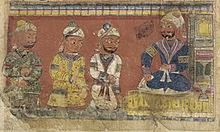Nizamuddin Chishti
| Nizamuddin Auliya | |
|---|---|
| محمد نظام الدّین اولیاء | |

Nizamuddin Auliya with three attendants,
Folio from a Khamsa (Quintet) by Amir Khusraw Dihlavi – ca. 1450 |
|
| Religion | Islam |
| Order | Chisti order |
| Personal | |
| Born | 1238 Badayun (present-day Uttar Pradesh) |
| Died | 3 April 1325 Delhi |
| Senior posting | |
| Based in | Delhi |
| Period in office | Late 13th century and early 14th century |
| Predecessor | Fariduddin Ganjshakar |
| Successor | Various, most prominent being Nasiruddin Chiragh Dehlavi, Amir Khusrow, Gmm Nizamuddin,Akhi Siraj Aainae Hind and Burhanuddin Gharib |
Muhammad Nizamuddin Auliya (Urdu: محمد نظام الدّین اولیاء; sometimes spelled Awliya; 1238 – 3 April 1325), also known as Hazrat Nizamuddin, was a Sufi saint of the Chishti Order and arguably one of the most famous Sufis on the Indian Subcontinent. His predecessors were Fariduddin Ganjshakar, Qutbuddin Bakhtiyar Kaki and Moinuddin Chishti. In that sequence, they constitute the initial spiritual chain or silsila of the Chishti order, widely prevalent in the Indian subcontinent.
Nizamuddin Auliya, like his predecessors, stressed love as a means of realising God. For him his love of God implied a love of humanity. His vision of the world was marked by a highly evolved sense of religious pluralism and kindness. It is claimed by the 14th century historiographer Ziauddin Barani that his influence on the Muslims of Delhi was such that a paradigm shift was effected in their outlook towards worldly matters. People began to be inclined towards mysticism and prayers and remaining aloof from the world.
Nizamuddin Auliya was born in Badayun, Uttar Pradesh (east of Delhi). At the age of five, after the death of his father, Syed Abdullah bin Ahmad AlHussaini Badayuni, he came to Delhi with his mother, Bibi Zulekha. His biography finds mention in Ain-i-Akbari, a 16th-century document written by Mughal Emperor Akbar’s vizier, Abu'l-Fazl ibn Mubarak.
...
Wikipedia
